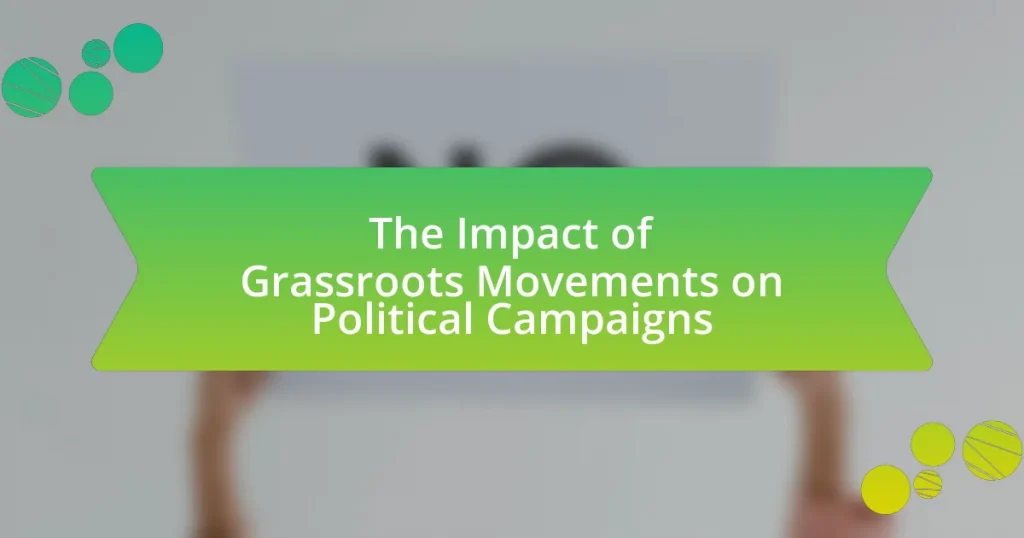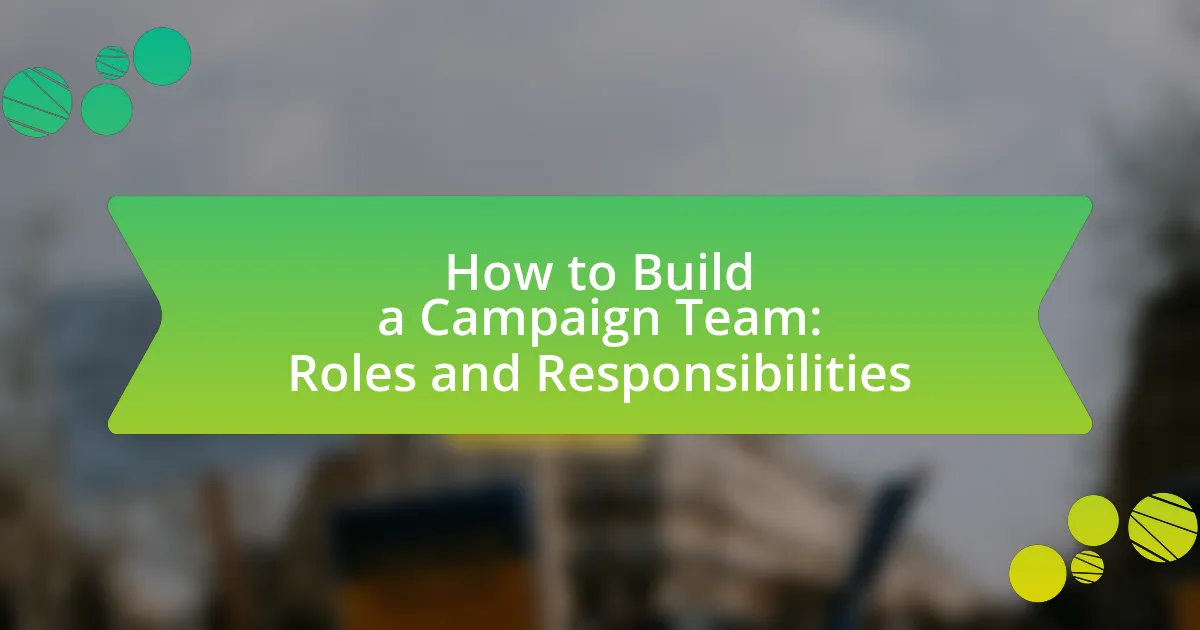Grassroots movements are organized efforts by ordinary citizens aimed at influencing political decisions and policies at various levels. This article examines the significant role these movements play in political campaigns, highlighting their ability to mobilize community support, raise awareness on critical issues, and enhance voter engagement. Key strategies employed by grassroots movements, such as community organizing and social media engagement, are discussed, along with their differences from traditional political campaigns. The article also addresses the challenges faced by grassroots initiatives, including funding limitations and media coverage, while emphasizing their importance in modern politics and their impact on voter turnout and public opinion.
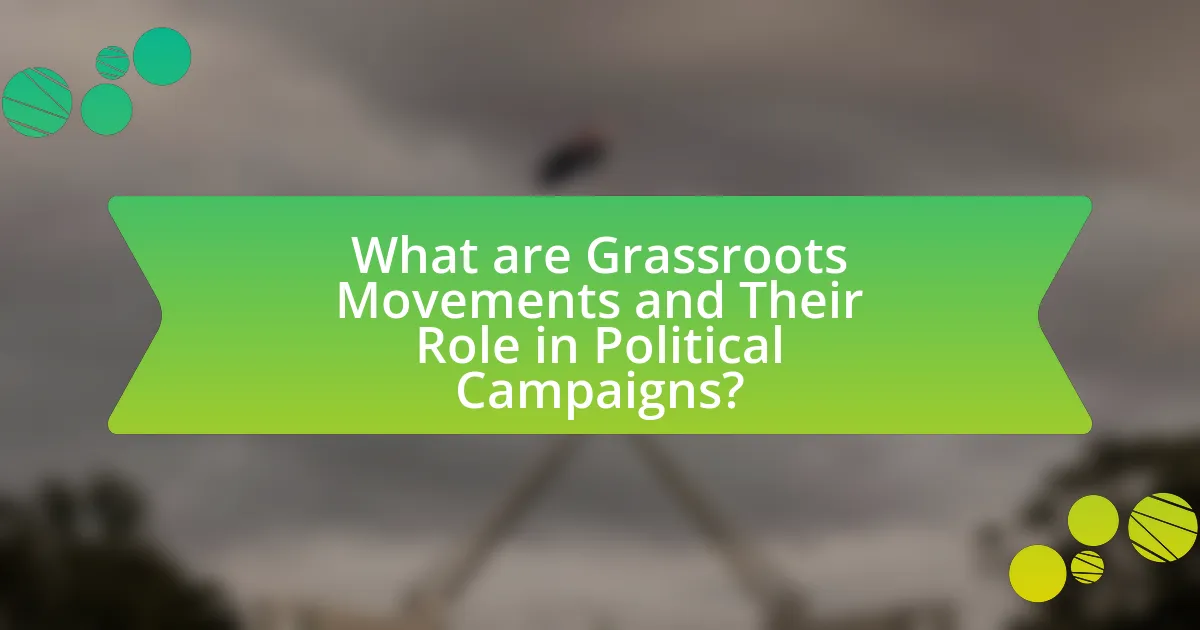
What are Grassroots Movements and Their Role in Political Campaigns?
Grassroots movements are organized efforts by ordinary people to influence political decisions and policies at the local, state, or national level. These movements play a crucial role in political campaigns by mobilizing community support, raising awareness about specific issues, and fostering grassroots engagement that can lead to significant electoral outcomes. For example, the 2008 Obama campaign effectively utilized grassroots organizing to engage millions of volunteers, resulting in a record voter turnout and a historic election victory. This demonstrates that grassroots movements can significantly amplify the voices of constituents, shape political narratives, and ultimately impact the success of political campaigns.
How do grassroots movements influence political engagement?
Grassroots movements significantly influence political engagement by mobilizing individuals at the community level to participate in political processes. These movements often raise awareness about specific issues, encouraging citizens to become active in advocacy, voting, and civic discussions. For instance, the Black Lives Matter movement has galvanized millions to engage in protests and discussions about racial justice, leading to increased voter turnout in local and national elections. Research indicates that grassroots efforts can lead to a 20% increase in voter participation in areas where such movements are active, demonstrating their effectiveness in enhancing political engagement.
What strategies do grassroots movements employ to mobilize supporters?
Grassroots movements employ strategies such as community organizing, social media engagement, and coalition building to mobilize supporters. Community organizing involves identifying local leaders and fostering relationships to create a network of engaged individuals who can advocate for shared goals. Social media engagement allows grassroots movements to reach a wider audience quickly, facilitating the dissemination of information and mobilization efforts through platforms like Facebook and Twitter. Coalition building involves partnering with other organizations to amplify voices and resources, enhancing the movement’s reach and effectiveness. These strategies have been proven effective; for instance, the 2018 midterm elections in the United States saw a significant increase in voter turnout attributed to grassroots efforts, with organizations like Indivisible mobilizing millions of supporters through these methods.
How do grassroots movements differ from traditional political campaigns?
Grassroots movements differ from traditional political campaigns primarily in their structure and funding sources. Grassroots movements are typically community-driven initiatives that rely on local volunteers and small donations, emphasizing collective action and social change, while traditional political campaigns often involve organized efforts led by established political parties with significant financial backing from large donors and corporate sponsors. For example, the 2016 Bernie Sanders campaign exemplified a grassroots approach, raising over $230 million from small contributions, contrasting with the 2016 Hillary Clinton campaign, which received substantial funding from major donors and PACs. This fundamental difference in approach influences the strategies, messaging, and engagement levels of each type of campaign.
Why are grassroots movements important in modern politics?
Grassroots movements are important in modern politics because they empower ordinary citizens to influence political decisions and policies. These movements mobilize community members around shared interests, fostering civic engagement and increasing political participation. For instance, the Black Lives Matter movement has significantly impacted discussions on racial justice and police reform, demonstrating how grassroots activism can shape national dialogue and policy changes. Additionally, grassroots movements often challenge established political structures, leading to more representative governance and accountability, as seen in the rise of progressive candidates in various elections who have gained support through grassroots organizing.
What impact do grassroots movements have on voter turnout?
Grassroots movements significantly increase voter turnout by mobilizing communities and fostering engagement. Research indicates that grassroots efforts, such as door-to-door canvassing and community organizing, create personal connections that motivate individuals to participate in elections. For instance, a study by the Harvard Kennedy School found that face-to-face interactions can increase voter turnout by as much as 10%. Additionally, grassroots movements often focus on issues that resonate with local populations, thereby enhancing the relevance of voting and encouraging higher participation rates.
How do grassroots movements shape public opinion on key issues?
Grassroots movements shape public opinion on key issues by mobilizing community engagement and fostering collective action. These movements often utilize social media platforms to disseminate information, raise awareness, and create a sense of urgency around specific topics, such as climate change or social justice. For instance, the Black Lives Matter movement significantly influenced public discourse on racial inequality and police reform, leading to widespread protests and policy discussions across the United States. Research indicates that grassroots campaigns can shift public attitudes; a study by the Pew Research Center found that public support for Black Lives Matter increased from 38% in 2016 to 67% in 2020, demonstrating the effectiveness of grassroots efforts in shaping perceptions and driving change.
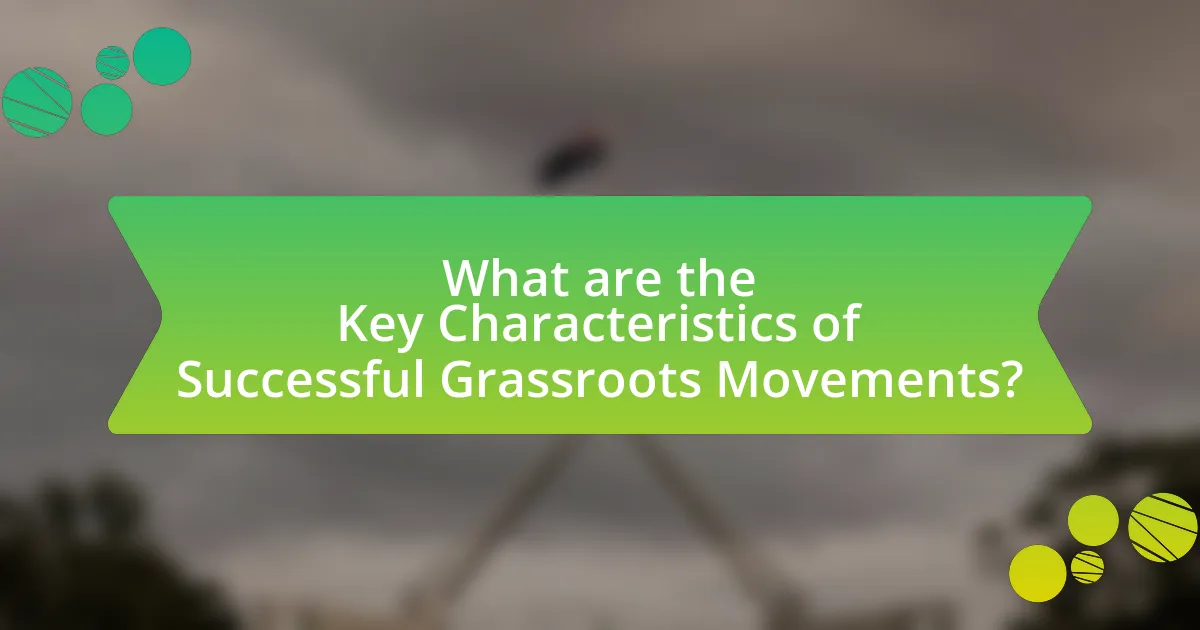
What are the Key Characteristics of Successful Grassroots Movements?
Successful grassroots movements are characterized by strong community engagement, clear messaging, and effective organization. Community engagement fosters a sense of ownership and mobilizes individuals to participate actively, as seen in movements like the Civil Rights Movement, where local involvement was crucial for success. Clear messaging ensures that the movement’s goals resonate with a broad audience, exemplified by the Women’s March, which unified diverse groups under a common cause. Effective organization, including strategic planning and resource allocation, allows grassroots movements to operate efficiently and adapt to challenges, as demonstrated by the success of the Black Lives Matter movement in mobilizing protests and influencing policy discussions. These characteristics collectively enhance the impact of grassroots movements on political campaigns by amplifying voices and driving social change.
What factors contribute to the effectiveness of grassroots movements?
The effectiveness of grassroots movements is primarily influenced by community engagement, clear messaging, and strategic use of social media. Community engagement fosters a sense of ownership and mobilizes individuals to participate actively, as seen in the success of movements like Black Lives Matter, which galvanized widespread local participation. Clear messaging ensures that the movement’s goals resonate with the public, exemplified by the Women’s March, which effectively communicated its objectives and values. Additionally, strategic use of social media amplifies outreach and mobilization efforts, as demonstrated by the Ice Bucket Challenge, which raised awareness and funds for ALS through viral sharing. These factors collectively enhance the ability of grassroots movements to influence political campaigns and drive social change.
How does community involvement enhance grassroots initiatives?
Community involvement enhances grassroots initiatives by fostering local engagement and support, which increases the effectiveness and reach of these initiatives. When community members actively participate, they contribute valuable insights, resources, and networks that can amplify the initiative’s goals. For instance, a study by the Stanford Social Innovation Review found that grassroots movements with strong community ties are more likely to achieve their objectives, as they leverage local knowledge and mobilize volunteers effectively. This active participation not only builds trust but also creates a sense of ownership among community members, leading to sustained efforts and greater impact in political campaigns.
What role does social media play in grassroots mobilization?
Social media serves as a crucial tool for grassroots mobilization by facilitating rapid communication and organization among supporters. It enables grassroots movements to disseminate information quickly, rally participants for events, and amplify their messages to a broader audience. For instance, during the 2011 Arab Spring, social media platforms like Twitter and Facebook were instrumental in organizing protests and sharing real-time updates, demonstrating their effectiveness in mobilizing large groups for political action. Additionally, studies have shown that social media can increase engagement and participation in grassroots campaigns, as evidenced by the 2016 U.S. presidential election, where platforms were used extensively to mobilize voters and organize grassroots efforts.
How do grassroots movements build coalitions and alliances?
Grassroots movements build coalitions and alliances by fostering relationships based on shared goals and values among diverse groups. These movements often engage in outreach efforts, such as community meetings and social media campaigns, to identify common interests and mobilize support. For instance, the Women’s March in 2017 successfully united various organizations advocating for women’s rights, racial justice, and LGBTQ+ rights, demonstrating how a shared cause can bring together disparate groups. Additionally, grassroots movements leverage local networks and existing organizations to amplify their reach and influence, creating a broader coalition that can effectively advocate for policy changes.
What are the benefits of forming alliances with other organizations?
Forming alliances with other organizations enhances resource sharing, expands reach, and increases influence in political campaigns. By collaborating, organizations can pool financial resources, expertise, and networks, which can lead to more effective grassroots movements. For instance, a study by the Stanford Social Innovation Review highlights that partnerships can amplify advocacy efforts, resulting in a 30% increase in campaign visibility and engagement. This collaborative approach not only strengthens the message but also fosters a united front, making it easier to mobilize supporters and achieve common goals.
How can grassroots movements leverage partnerships for greater impact?
Grassroots movements can leverage partnerships for greater impact by collaborating with established organizations, which can provide resources, expertise, and wider networks. For instance, partnerships with non-profits or advocacy groups can enhance visibility and credibility, allowing grassroots movements to reach larger audiences and mobilize more supporters. Research indicates that coalitions formed between grassroots organizations and larger entities can increase funding opportunities and access to strategic training, as seen in the collaboration between the grassroots organization Black Lives Matter and various civil rights groups, which amplified their collective voice and influence in political discourse.
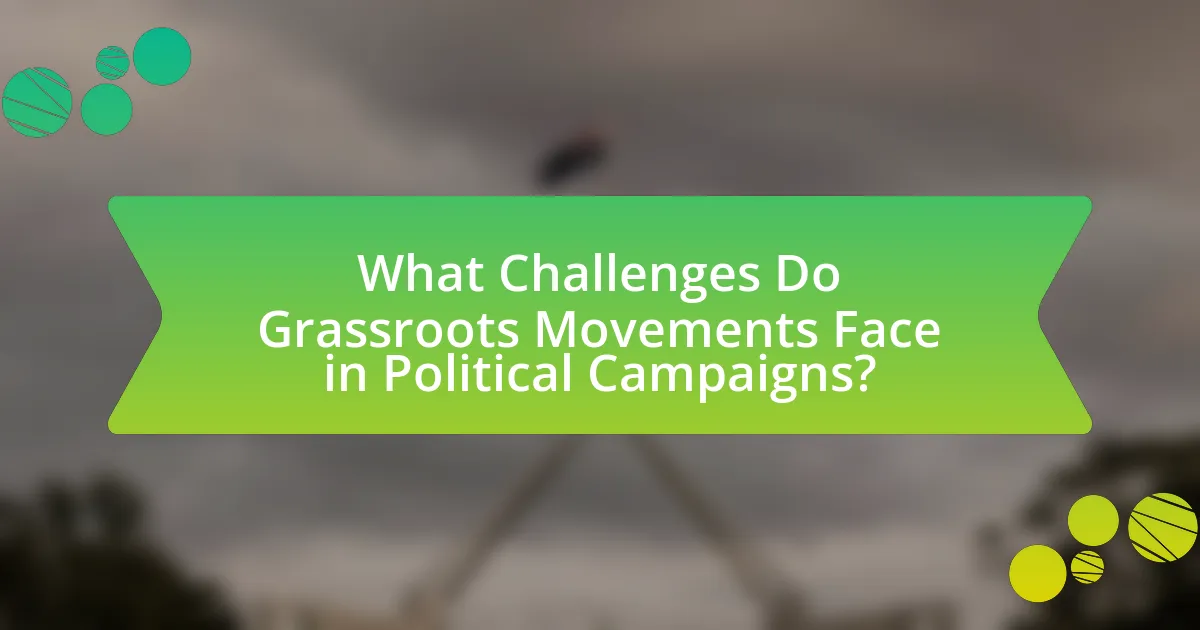
What Challenges Do Grassroots Movements Face in Political Campaigns?
Grassroots movements face significant challenges in political campaigns, primarily due to limited funding and resources. These movements often rely on small donations and volunteer efforts, which can hinder their ability to compete against well-funded opponents. For instance, a study by the Center for Responsive Politics found that candidates with substantial financial backing are more likely to win elections, creating an uneven playing field for grassroots initiatives. Additionally, grassroots movements frequently struggle with gaining media attention, as mainstream outlets may prioritize larger campaigns, further diminishing their visibility and impact. This lack of exposure can result in lower public awareness and support, making it difficult for grassroots movements to mobilize voters effectively.
What obstacles hinder the success of grassroots movements?
Grassroots movements face several obstacles that hinder their success, including limited funding, lack of media coverage, and internal organizational challenges. Limited funding restricts the ability to mobilize resources effectively, as many grassroots initiatives rely on small donations and volunteer efforts. Lack of media coverage can prevent these movements from gaining visibility and support, as mainstream media often prioritizes larger, established organizations. Internal organizational challenges, such as differing goals among members and inadequate leadership structures, can lead to fragmentation and reduced effectiveness. These factors collectively impede the ability of grassroots movements to influence political campaigns and achieve their objectives.
How do funding limitations affect grassroots initiatives?
Funding limitations significantly hinder grassroots initiatives by restricting their ability to mobilize resources, engage communities, and sustain operations. Without adequate financial support, grassroots organizations struggle to implement effective outreach strategies, limiting their capacity to raise awareness and influence political agendas. For instance, a study by the National Committee for Responsive Philanthropy found that organizations with limited funding often face challenges in hiring skilled staff, which directly impacts their effectiveness in advocacy and community engagement. Consequently, these funding constraints can lead to diminished visibility and reduced impact on political campaigns, ultimately undermining the goals of grassroots movements.
What strategies can grassroots movements use to overcome these challenges?
Grassroots movements can overcome challenges by leveraging community engagement, utilizing social media for outreach, and forming coalitions with like-minded organizations. Community engagement fosters a sense of ownership and mobilizes local support, which is crucial for sustaining momentum. For instance, the Black Lives Matter movement effectively utilized community organizing to address systemic racism, demonstrating the power of localized efforts. Social media platforms enable grassroots movements to reach wider audiences quickly and efficiently, as seen in the viral spread of the #MeToo movement, which galvanized global awareness and support. Additionally, forming coalitions allows grassroots movements to pool resources and amplify their voices, as evidenced by the Women’s March, which united various groups to advocate for women’s rights on a larger scale. These strategies collectively enhance the effectiveness and resilience of grassroots movements in the political landscape.
How do grassroots movements respond to opposition from established political entities?
Grassroots movements respond to opposition from established political entities by mobilizing community support, leveraging social media, and employing strategic advocacy tactics. For instance, when faced with pushback, grassroots organizations often organize protests, rallies, or community meetings to galvanize public opinion and demonstrate collective strength. A notable example is the Women’s March in 2017, which drew millions globally in response to perceived threats from the Trump administration, showcasing the ability of grassroots movements to unify and amplify their message against established political opposition. Additionally, these movements utilize social media platforms to disseminate information rapidly, counter misinformation, and engage supporters, as seen in the Black Lives Matter movement, which effectively used Twitter and Instagram to raise awareness and organize actions in response to systemic racism and police violence. These strategies illustrate how grassroots movements adapt and respond dynamically to challenges posed by established political entities.
What tactics do grassroots movements use to counteract negative campaigning?
Grassroots movements counteract negative campaigning through tactics such as community engagement, positive messaging, and rapid response strategies. Community engagement involves mobilizing local supporters to create a strong network that can amplify positive narratives and counter misinformation. Positive messaging focuses on highlighting the values and achievements of the movement or candidate, thereby shifting the conversation away from negative attacks. Rapid response strategies enable grassroots organizations to quickly address and refute false claims or negative ads, often utilizing social media platforms to disseminate accurate information swiftly. These tactics have been effective in various campaigns, as evidenced by the success of grassroots efforts in the 2018 midterm elections, where organizations like Indivisible mobilized voters to counteract negative campaigning effectively.
How can grassroots movements maintain momentum in the face of adversity?
Grassroots movements can maintain momentum in the face of adversity by fostering strong community engagement and utilizing effective communication strategies. Engaging local communities creates a sense of ownership and commitment, which is crucial during challenging times. For instance, the Black Lives Matter movement effectively mobilized supporters through community organizing and local events, which helped sustain its momentum despite significant opposition. Additionally, leveraging social media platforms allows grassroots movements to disseminate information rapidly, rally support, and counteract negative narratives. Research shows that movements that maintain consistent communication with their base are more likely to endure challenges, as seen in the success of the Women’s March, which continued to mobilize participants through ongoing outreach and advocacy efforts.
What are the best practices for launching a successful grassroots campaign?
The best practices for launching a successful grassroots campaign include building a strong community network, utilizing social media effectively, and engaging in direct voter outreach. A strong community network fosters relationships and mobilizes supporters, which is essential for grassroots efforts; for instance, the 2008 Obama campaign effectively utilized local volunteers to create a vast network of supporters. Utilizing social media allows campaigns to reach a broader audience quickly and cost-effectively, as demonstrated by the viral success of various movements that gained traction online. Engaging in direct voter outreach, such as door-to-door canvassing and phone banking, has been shown to significantly increase voter turnout, with studies indicating that personal contact can boost turnout by as much as 10%. These practices collectively enhance the effectiveness and reach of grassroots campaigns.
How can grassroots organizers effectively engage their communities?
Grassroots organizers can effectively engage their communities by fostering relationships through active listening and inclusive dialogue. This approach allows organizers to understand community needs and concerns, which can be validated by studies showing that community involvement increases trust and participation in local initiatives. For instance, research from the Stanford Social Innovation Review indicates that organizations that prioritize community input see a 30% increase in volunteer engagement. By utilizing tools such as social media, community meetings, and local events, grassroots organizers can create platforms for discussion and collaboration, ensuring that community voices are heard and valued.
What tools and resources are essential for grassroots campaign success?
Essential tools and resources for grassroots campaign success include social media platforms, community organizing software, and volunteer management systems. Social media platforms like Facebook and Twitter enable campaigns to reach a broad audience quickly and engage supporters effectively. Community organizing software, such as NationBuilder or Mobilize, helps manage outreach efforts, track interactions, and coordinate events. Volunteer management systems streamline recruitment, scheduling, and communication with volunteers, which is crucial for mobilizing grassroots efforts. According to a study by the Pew Research Center, 69% of adults in the U.S. use social media, highlighting its importance in grassroots campaigning.
